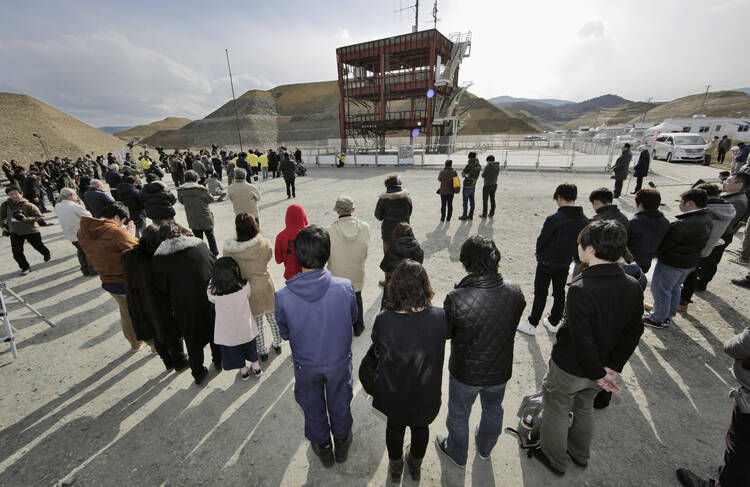Japanese gathered in Tokyo and along the country's ravaged northeast coast to observe a moment of silence at 2:46 p.m. on March 11, exactly five years after a magnitude-9.0 earthquake struck offshore, triggering a devastating tsunami that killed more than 18,000 people and sent reactors at the Fukushimanuclear plant into meltdown.
Some teared up as they held hands or bowed their heads in prayer as sirens sounded on a chilly afternoon in northern Japan. Japanese Emperor Akihito, Empress Michiko and Prime Minister Shinzo Abe, all in formal wear, led a ceremony in Tokyo attended by officials and survivors.
"Many of the people affected by the disaster are aging, and I worry that some of them may be suffering alone in places where our eyes and attention don't reach," Akihito said. "It is important that all the people keep their hearts together so that not a single person still in difficulty is overlooked and they can return to normal life as soon as possible."
Five years on, the most heavily damaged communities have yet to be rebuilt. About 180,000 people are still displaced, including those reluctant to return to homes in Fukushima. Much of the disaster-hit Tohoku coast remains empty except for huge mounds of dirt that are raising the ground to minimize the risk of future tsunami before any rebuilding.
Abe acknowledged that many people are still struggling, but said "reconstruction is steadily making progress, step by step, with housing being rebuilt and jobs regained."
His Cabinet approved on March 11 a new 6.5 trillion yen ($57 billion) five-year reconstruction plan through 2020 to speed up construction of public housing for evacuees, and for medical care, infrastructure, tourism promotion and other projects.
At a Buddhist temple in the tsunami-ravaged city of Rikuzentakata, memorial prayers were offered for the more than 1,700 residents who perished, including about 200 whose bodies were never recovered.
"The best thing would be for things to go back as they were, but of course that's not how the world works," said 37-year-old Tadayuki Kumagai, who lost his parents. He considers himself fortunate, because their bodies were found.
"Even if it's impossible to go back to the way things were before the disaster, everyone hopes that living standards will at least come closer to what they were," he said. "I think that's what rebuilding means."
Housing is an acute problem, with some still in temporary quarters, said Zuishu Sugawara, the temple's chief monk. Forty-seven members of the temple are among the missing.
"In form, perhaps reconstruction might happen, but in terms of recovering from the scars of the heart..." he said, pausing. "I think there are some who might never heal."
Early in the day, a handful of people paid respects in the town of Minamisanriku at the skeletal remains of the former disaster prevention center, where 43 workers died as tsunami waves engulfed the three-story building.
Masaki Kamei, a doctor from Tokyo who has been visiting the disaster areas every year, said he senses a change.
"What's different this year compared to last year is fishermen have already gone out fishing by dawn ... and towns are already bustling about going on with their business," he said. "There is an expression: the hammering sound of reconstruction. That's how I feel, I sense the emphasis has shifted."
Still, it seems a long road ahead before the streets of coastal communities will be lined with homes and shops again.
___
Yamaguchi reported from Tokyo.
Copyright 2016 The Associated Press. All rights reserved. This material may not be published, broadcast, rewritten or redistributed.







